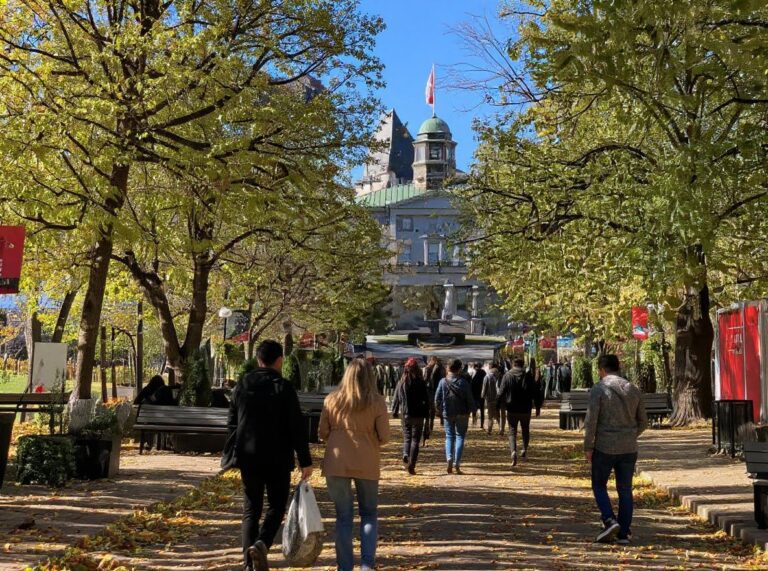
When international student Kasvi Khosla, who is currently studying in Toronto, Canada, first heard about the CA$9 billion federal aid package that was announced in April by Canadian Prime Minister Justin Trudeau, she felt a wave of relief.
The New Delhi native thought: “OK, I can apply for this.”
But that relief quickly dissipated when she learned that she did not meet all the criteria to be eligible for CERB — or the Canada Emergency Response Benefit — a government scheme that offers temporary income support for citizens and taxpayers during the COVID-19 outbreak.
The Canadian government notes on its website that the CERB is eligible for those residing in Canada who are at least 15 years old, have stopped working because of reasons related to COVID-19, earned at least CA$5,000 in 2019 or in the 12 months prior to the date of their application, and who have not quit their job voluntarily.
 In this file photo Canadian Prime Minister Justin Trudeau speaks during a news conference on COVID-19 situation in Canada from his residence in Ottawa, Canada on March 23, 2020. Source: Dave Chan
In this file photo Canadian Prime Minister Justin Trudeau speaks during a news conference on COVID-19 situation in Canada from his residence in Ottawa, Canada on March 23, 2020. Source: Dave Chan
Under this scheme, Canadian taxpayers are entitled to CA$500 a week for up to 16 weeks.
“I was very excited about it, but then I got to know that you’ve got to at least earn CA$5,000 in the previous year,” said the 21-year-old to Study International via a Zoom interview.
She hadn’t earned enough from her part-time jobs to make her eligible for the scheme.
Kasvi is currently pursuing a postgraduate diploma in Public Relations-Corporate Communications at Sheridan College. As an international student, she is allowed to work up to 20 hours per week while class is in session.
While she’s lucky not to have lost her part-time jobs, her hours have been slashed since the COVID-19 pandemic.
While the Canadian government announced on April 22 that international students working in essential services or functions can work full-time to help in the fight against COVID-19, this has done little to allay the fears of international students in Canada who don’t fall in this category.
Effective immediately, international students in 🇨🇦 are able to work more than 20 hrs per week while classes are in session if they are working in an essential service or function such as health care, the supply of food or other critical goods. Learn more: https://t.co/bm7iJFf7oc pic.twitter.com/mP8hxaJNwZ
— IRCC (@CitImmCanada) April 22, 2020
She feels disheartened by the lack of support, arguing that international students in the country do contribute to the Canadian economy. She also pays up to triple the number of tuition fees than her friends who are local.
“I pay my rent here. I get my groceries here. I don’t order things from India — I shop local,” said the literature graduate.
She had earlier tweeted her dismay over the lack of support for pockets of international students who do not qualify for the COVID-19 emergency benefit, and said her DMs were “flooded with so much hate”.
People have told her that she’s “not actually Canadian” and thus does not deserve the emergency relief benefit and that she should also go back to where she came from.
“Of course I’m not going back because the borders [in India] are closed. So I can’t go back. Secondly, I pay my taxes here. I’m a student here,” she said, adding that many international students have also lost their jobs.
While universities are offering one-time bursaries to students who have been affected by the pandemic, Kasvi notes that the government can also step in to help students.
She adds that she doesn’t expect “free money,” but notes that some form of financial aid that can help students cover their rent and groceries would be helpful.
“Next year, when we file our taxes, we should be able to pay it back,” she said.
The outbreak has also affected her plans for the summer.
“My plan was to work throughout the summer and earn enough to pay for my next course so that I don’t have to constantly ask my parents,” she said. But this will unlikely be the case under the current circumstances.
CERB for students eligibility criteria too stringent from international students?
 Some international students who didn't benefit from CERB hope to get some form of support. Source: Nicholas Kamm
Some international students who didn't benefit from CERB hope to get some form of support. Source: Nicholas Kamm
While Kasvi represents just one of the many international students in Canada who have been affected by the global health crisis, some movements are steadily gaining traction for international students who have fallen through the cracks.
For instance, a petition by Migrant Students, a project of Migrant Workers Alliance for Change, to support international students in Canada has already garnered over 10,400 signatures — close to its 11,000 goal — at the time of writing.
“Thousands of migrant students have spoken out about how the COVID-19 crisis is affecting us. We have lost work or income, we are struggling to pay bills and high tuition fees, we have limited access to health care, we are concerned for our futures in Canada, and we have been separated from our families by border closures,” it said.
“The government’s response to this public health crisis so far has not included us.”
As we continue to rally for our rights & protections, keep posting, sharing, and inviting your friends – there is strength in numbers! #MigrantStudentsUnited pic.twitter.com/W9BB3CDK3U
— Migrant Workers Alliance for Change (@MWACCanada) April 29, 2020
Canada has a burgeoning international student market. They are the world’s third-leading destination for international students, with over half a million (642,000) foreign students, according to government data.
Ontario hosts almost 50 percent of the country’s international student population, while 34 percent of Canada’s international students come from India, it said.
They contribute an estimated CA$22 billion annually to the country’s economy and help to sustain over 170,000 jobs, according to government research.
Pumping billions into the Canadian economy aside, international students are also a major source of revenue for many colleges and universities in the country.
With international students contributing billions to the Canadian economy, is the country doing enough to protect its students in the current climate?
Liked this? Then you’ll love…
CERB payments: 5 things international students should know
CESB vs CERB: What’s the difference and are international students in Canada eligible for both?







